
Hitoyoshi is a city in Kumamoto Prefecture, Japan. The city was founded on February 11, 1942. As of November 2022, the city has an estimated population of 30,752 and a population density of 144 per km2. The total area is 210.55 km2.

The Kyushu Railway Company, also referred to as JR Kyushu, is one of the seven constituent companies of Japan Railways Group. It operates intercity rail services within Kyushu, Japan and the JR Kyushu Jet Ferry Beetle hydrofoil service across the Tsushima Strait between Fukuoka and Busan, South Korea. It also operates hotels, restaurants, and drugstores across its service region. JR Kyushu's headquarters are in Hakata-ku, Fukuoka.
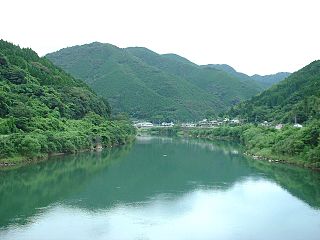
The Kuma River is a river in Kumamoto Prefecture, central Western part of Kyūshū, Japan. It is sometimes referred as Kumagawa River. It is the longest river in Kyushu, with the length of 115 km long and has a drainage area of 1,880 km2 (730 sq mi). The tidal flat of the Kuma River estuary is approximately 1000 hectares.

Typhoon Chataan, known in the Philippines as Typhoon Gloria, was the deadliest natural disaster in the history of Chuuk, a state in the Federated States of Micronesia (FSM). The typhoon formed on June 28, 2002, near the FSM, and for several days it meandered while producing heavy rainfall across the region. On Chuuk, the highest 24-hour precipitation total was 506 mm (19.9 in), which was greater than the average monthly total. The rain produced floods up to 1.5 m (4.9 ft) deep, causing landslides across the island that killed 47 people. There was also one death on nearby Pohnpei, and damage in the FSM totaled over $100 million.
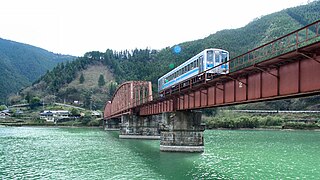
The Hisatsu Line is a railway line in Kyushu, Japan, operated by the Kyushu Railway Company. It connects Yatsushiro on the Kagoshima Main Line to Hayato station, Kirishima on the Nippo Main Line. From 1909 the line was the original rail connection from Yatsushiro to Kagoshima until the Yatsushiro – Kagoshima coastal route via Sendai opened in 1927.

The Yunomae Line is a railway line in Kumamoto Prefecture, Japan, connecting Hitoyoshi-Onsen Station in Hitoyoshi and Yunomae Station in Yunomae. It is the only railway line operated by the third sector Kumagawa Railroad. As the company name suggests, the line parallels the Kuma River. The company is also called Kumatetsu (くま鉄). The company took over the former JR Kyushu line in 1989.

Typhoon Conson, known in the Philippines as Typhoon Frank, was the first of the record ten typhoons to impact Japan during the 2004 Pacific typhoon season. Developing out of a tropical depression near the northern Philippines in early June, Conson slowly traveled towards the north. Gradually strengthening, the storm reached typhoon status late on June 7 according to the Joint Typhoon Warning Center and several hours later according to the Japan Meteorological Agency. After turning towards the northeast, the typhoon brushed Taiwan and reached its peak intensity with winds of 150 km/h on June 9. After reaching its peak, Conson gradually weakened, passing through Okinawa before being downgraded to a tropical storm the next day. On June 11, the storm made landfall as a minimal tropical storm in the Kōchi Prefecture just before becoming extratropical. The extratropical remnants continued towards the northeast and were last mentioned on June 14 crossing the International Date Line.

Aoi Aso Shrine is a Shinto shrine in Hitoyoshi, Kumamoto Prefecture, Japan. It is colloquially known as Aoi-san (青井さん). It was originally established as a prefectural shrine, but is currently designated as a national shrine. Five of the structures within the shrine are listed as National Treasures of Japan.

Tropical Storm Etau was the deadliest tropical cyclone to impact Japan since Typhoon Tokage in 2004. Forming on August 8, 2009 from an area of low pressure, the system gradually intensified into a tropical storm. Tracking in a curved path around the edge of a subtropical ridge, Etau continued to intensify as it neared Japan. By August 10, the cyclone reached its peak intensity as a weak tropical storm with winds of 75 km/h and a barometric pressure of 992 hPa (mbar). Shortly after, Etau began to weaken. Increasing wind shear led to the center becoming devoid of convection and the system eventually weakened to a tropical depression on August 13. The remnants of Etau persisted for nearly three days before dissipating early on August 16.

The 2010 China floods began in early May 2010. Three hundred and ninety-two people died, and a further 232 people were reported missing as of June 30, 2010, including 57 people in a landslide in Guizhou. Fifty-three of the deaths occurred from the flooding and landslides between May 31 and June 3, and 266 deaths occurred between June 13 and June 29. Four hundred and twenty four people were killed by the end of June, including 42 from the Guizhou landslide; 277 more were killed and 147 were missing in the first two weeks of July, bringing the death toll as of August 5 to 1,072. A landslide in early August in Gansu killed at least 1,471 people and left 294 missing. In total, the flooding and landslides killed at least 3,185 people in China by August 31. More than 230 million people in 28 provinces, municipalities, and regions, especially the southern and central provinces and regions of Zhejiang, Fujian, Jiangxi, Hubei, Hunan, Guangdong, Guangxi, Chongqing Municipality, Gansu, Sichuan, and Guizhou, and the northeastern province of Jilin were affected, while at least 4.66 million people were evacuated because of the risk of flooding and landslides in the latter half of June. By early August, over 12 million people were evacuated, and that number rose to 15.2 million by August 31.
The 1993 Kagoshima flood was a series of heavy torrential rains which hit Kagoshima, Japan with debris flow in the early part of August 1993. The formal name in Japanese was the "August 1993 Heavy Rain" (平成5年8月豪雨). The death toll was 71, and about 2,500 people who were in cars, buses and trains were saved by fishing boats and ferries which carried them to Kagoshima through the Kagoshima Bay.

Tropical Storm Nakri, known in the Philippines as Tropical Storm Inday, was a large, long-lived, and slow-moving tropical cyclone that produced prolific rains over Japan and South Korea in early August 2014.
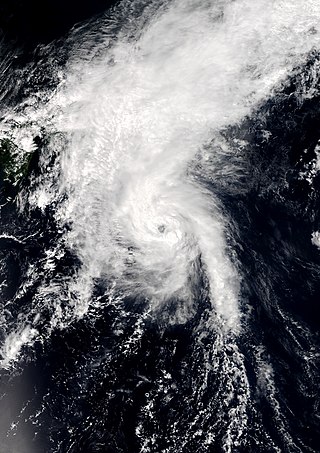
Severe Tropical Storm Etau caused extensive and destructive floods across eastern Japan during early September 2015. Originating from a tropical disturbance near Guam on September 2, Etau was first classified a tropical depression on September 5. Tracking generally north, the cyclone gradually intensified and reached its peak strength with winds of 95 km/h (60 mph) on September 8. The following day, Etau made landfall in Honshu, Japan. It subsequently transitioned into an extratropical cyclone later that day over the Sea of Japan.

Severe Tropical Storm Nanmadol, known in the Philippines as Severe Tropical Storm Emong, was a tropical cyclone that impacted southern Japan during July 2017. Nanmadol developed over in the Philippine Sea as a tropical depression on July 1, and strengthened into the third named storm of the 2017 typhoon season on July 3. After gaining organization, the system rapidly developed and intensified into a severe tropical storm and reached its peak intensity with a 10-minute maximum sustained winds of 100 km/h (65 mph) and a minimum barometric pressure of 985 hPa (29.09 inHg). On July 4, Nanmadol turned eastwards and made landfall near Nagasaki, Kyushu, just before it transitioned into an extratropical cyclone.

In late June through mid-July 2018, successive heavy downpours in southwestern Japan resulted in widespread, devastating floods and mudflows. The event is officially referred to as Heisei san-jū-nen shichi-gatsu gōu by the Japan Meteorological Agency. As of 20 July, 225 people were confirmed dead across 15 prefectures with a further 13 people reported missing. More than 8 million people were advised or urged to evacuate across 23 prefectures. It is the deadliest freshwater flood-related disaster in the country since the 1982 Nagasaki flood when 299 people died.
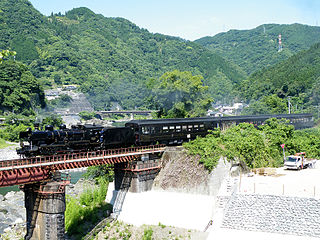
The SL Hitoyoshi is a named steam hauled excursion train operated by the Kyushu Railway Company on the Kagoshima Main Line and the Hisatsu Line since April 2009.
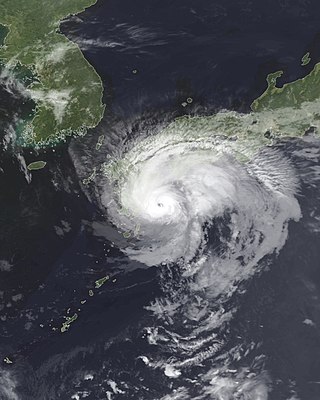
Typhoon Francisco was a small tropical cyclone that impacted Japan and the Korean Peninsula in August 2019. Originating from a trough over the open Pacific Ocean on July 29, Francisco developed into a tropical depression on August 1. Tracking along a northwest course toward Japan, the system steadily intensified over the following days. It attained typhoon strength on August 5 and soon struck Kyushu at peak strength with winds of 130 km/h (80 mph). Thereafter, the weakened storm traversed the Korea Strait before striking South Korea on August 6. Turning toward the east, Francisco transitioned into an extratropical cyclone on August 7. It later impacted Hokkaido before continuing across the northern Pacific and dissipating.
Between June and August 2020, floods severely impacted large areas of both North and South Korea due to heavy rains of the regional rainy season, primarily in the far southern parts of the Korean Peninsula. These floods are closely related to ones across China and in Kyushu, Japan. As of 9 August 2020, 30 people have died in South Korea as a result.

Typhoon Talim, known in the Philippines as Typhoon Lannie, was an intense and destructive tropical cyclone that affected parts of East Asia, especially Japan, during September 2017. The eighteenth named storm and the sixth typhoon of the 2017 Pacific typhoon season, Talim's origins can be traced back to an area of low-pressure that the Joint Typhoon Warning Center first monitored on September 6. The disturbance was upgraded to a tropical depression by the Japan Meteorological Agency only two days later, and it became a tropical storm on September 9, earning the name Talim. Talim grew stronger over the next few days, eventually becoming a typhoon the next day. Within a favorable environment, the typhoon rapidly intensified after passing through the Ryukyu Islands. However, as it moved eastward, Talim started to weaken due to wind shear, and on September 16, it was downgraded to a tropical storm. The storm passed over Japan, near Kyushu the next day, before becoming extratropical on September 18. The extratropical remnants were last noted by the JMA four days later, before dissipating fully on September 22.



















